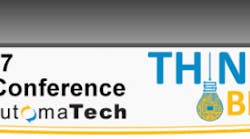In today’s complex manufacturing environment, there’s no one-size-fits-all automation solution to suit every company’s needs. No one knows that better than Toward Zero.
Don Rahrig and Aaron Muhl, co-founders of Toward Zero , recently spoke at AutomaTech’s ThinkBIG 2017 User Conference in Cape Cod, Massachusetts, and addressed that very issue as it applies to one of their customers who came to them needing an improved monitoring system for grain silos.
“A bunch of smaller companies supply grain to the big companies,” said Rahrig. “A farmer will have the 3-million- to 5-million-bushel site. They need a way to monitor for heat and spark as they transport the grain from truck to bin in this very explosive environment. They have to track bearing temperature. Hazard monitoring systems are OSHA-mandated. Bin temperature monitoring keeps track of the silo with thermocouples or sensors every 3 ft.”
[sidebar id =1]Traditionally temperature and moisture are measured once a day, in the morning, and written down. They’re looking for 1-3 °F change over a day. “We’ve put together a system for the hazard monitoring and the temperature monitoring and the conveyance all from one SCADA system,” said Muhl. “For us, it was about simplifying the control system. How do you automate a farmer being able to smell the corn and know its quality? In the past, you also had the data for the moment, but not the historical data. We are bringing it all to one area and making it cloud-based.”
Christopher Carlins, solution architect with AutomaTech, added, “The valuable data presented on the SCADA system is only available when physically at the silo location. To extend access out to the field, and beyond, Toward Zero is partnering with Webalo which provides a secure environment to deliver the data to the users on a native smartphone app. The flexible technology platform Webalo has built enables Toward Zero to communicate key issues right to the smart device and is bolstered by push-notification alerts and ability to download PDF reports on demand.”
Another Toward Zero customer, a complex automotive component manufacturer in central Indiana, is also currently benefiting from this kind of IT/OT convergence.
In 2015, this customer began a five-year MES modernization and functional expansion with Toward Zero. Concepts were for monitoring of automotive components in the field in 2016, and, as of 2017, PLM modernization discussions are in process.
“It’s a process of working through all of the data systems,” said Muhl. “We started to think through the digital thread and determine what the digital twin was for our customer’s automotive components. They were starting small with PLM and digitalization. The target of the component digital thread was to analyze existing products, build them better and more cost effectively, collect information from components running in the field and use the data to enhance designs and create additional value for consumers by constructing the digital twin.”
To get that to work, Toward Zero needed to help its customer to put all the data in one place with analytic tools.
“The goal is to drive better engineering and lower manufacturing costs,” said Rahrig. These in turn would drive tangible value-add to consumers and drive value-add services revenue.
The initiative began by starting small, targeting MES functional expansions and solving the big problems first. This reduction in costs helped to fund the bigger-picture efforts, such as creating digital models of existing designs.
Planning for a successful start and a long-term solution, Toward Zero suggested the use of the software GE Brilliant Manufacturing suite. “GE Plant Applications is at the core of GE BMS and the on-ramp to the full GE Digital solution,” said Carlins, providing additional details. “Its mature database and data models for contextualization of manufacturing processes enable a manufacturer to quickly pull data together for better-informed decisions.”
While achieving a long-term vision of how the digital journey can empower a manufacturer to thrive well into the 21st century, it is important to start small and make incremental improvements. “Find a problem and solve it quickly. We developed a target use case for analytics and used the data collected from the analytics to predict how new designs will perform,” said Rahrig. “The more information they get from machine tools on the shop floor, the more they can keep machines in working condition. You get more uptime. We discovered opportunities to recondition equipment not easily replaced and altered the culture to include empowerment by helping users to be better informed.”




